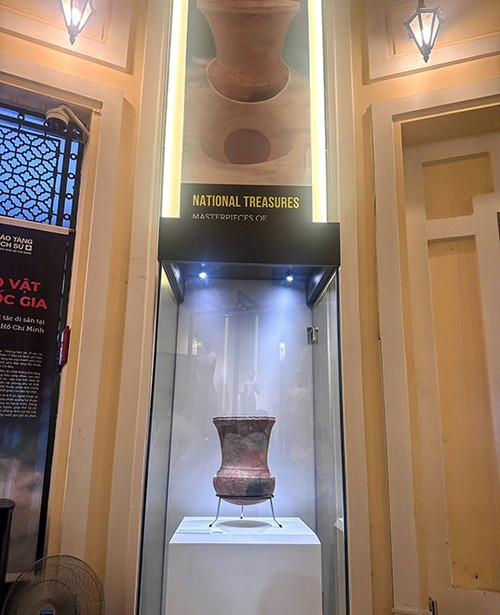
The Dong Tien ceramic steamer on display at the museum.
The Dong Tien ceramic steamer, part of the private collection of Pham Gia Chi Bao in District 2, Thu Duc City (Ho Chi Minh City), dates back approximately 2,000 to 2,500 years.
On December 31, 2024, it became the only ceramic object from the Dong Son culture to be officially recognized as a national treasure by the Prime Minister.
Among the “Ceramics from the nation’s founding era” collection owned by Pham Gia Chi Bao, the “Dong Tien ceramic steamer” holds special historical and artistic value. It was discovered in Dong Tien commune, Dong Son district (Thanh Hoa Province), along the banks of the Ma River.
After extensive research and analysis of its materials, color, production techniques, and decorative motifs, archaeologists and the national appraisal council confirmed that the artifact belongs to the Dong Son cultural period.
The Dong Son culture, which thrived around 2,500 years ago, was known for its advanced bronze casting, metalworking, pottery, and jewelry-making. It also saw the flourishing of wet rice agriculture in the Red, Ma, and Ca river basins.
Scientific evidence, including archaeological and ethnographic findings, shows that ancient Vietnamese communities practiced rice farming, animal husbandry, and gardening.
Grains and ceramic steamers for cooking sticky rice have been found in pre-Dong Son relics throughout the Red River basin.
Ethnographic and archaeological records also confirm that boiling food and consuming cooked rice (both glutinous and regular varieties) was a major culinary practice of early Vietnamese societies.
The Dong Son people created a specialized tool for steaming food using water vapor, commonly known as a "steamer" or "cho."
This artifact is considered one of the most valuable utilitarian items among Dong Son cultural relics, created by the Lac Viet people.
Despite its significance, ceramic steamers are rare compared to other Dong Son pottery types like pots, basins, jars, bowls, bottles, bronze-cooking pots, and molds. To date, only seven Dong Son ceramic steamers have been discovered, most of which are incomplete.
The Dong Tien steamer is the most intact and largest example, with a balanced form and signature Dong Son decorative patterns.
The Dong Tien ceramic steamer exemplifies the advanced ceramic techniques of Vietnam’s prehistoric and protohistoric eras. It was designed to cook rice using steam, one of the most progressive methods of its time.
The steamer is 40 cm tall, made from clay mixed with sand and vegetal matter, and fired at 800-900°C. It was shaped on a rotating table combined with hand modeling and a "paddle and anvil" technique, allowing it to cook food using steam.
The structure includes two levels: the upper chamber for holding food to be steamed, and the lower pot for boiling water.
The upper part is 23 cm high, with a flared truncated-cone body, a slightly outward mouth, and a rimmed groove.
The bottom pot is 17 cm high, round-bodied with a convex base and a shoulder ridge. The steamer tray between the two chambers contains small holes.
A raised ridge decorates the joining area of the two parts. Its exterior features rope-impressed and smoothed patterns, combining aesthetic appeal with structural integrity, helping the vessel withstand firing without cracking and distribute heat evenly during use.
The Dong Tien steamer stands out with its elegant, unique design compared to other cooking and storage pottery from the Dong Son period.
This artifact provides invaluable physical evidence of the material, spiritual, and religious life of ancient Vietnamese communities. It also reflects agricultural rituals and beliefs of the Dong Son culture.
The discovery of ceramic steamers at Dong Son cultural sites vividly demonstrates that people in this era already used steam to cook glutinous rice - and possibly other foods - creating xoi (steamed sticky rice), a traditional dish still central to Vietnamese ceremonies and daily life for over 2,500 years.
On June 29, at the Ho Chi Minh City Museum of History (2 Nguyen Binh Khiem Street, District 1), the city’s Department of Culture and Sports announced the national treasure designation and opened a special exhibition titled “National Treasures - Masterpieces of Heritage in Ho Chi Minh City.” The exhibition runs from June 29 to July 10.
As of 2025, Vietnam has recognized 327 national treasures, including individual and grouped artifacts. Ho Chi Minh City houses 17 of them at the Museum of History, the Museum of Fine Arts, and various private collections.
PV